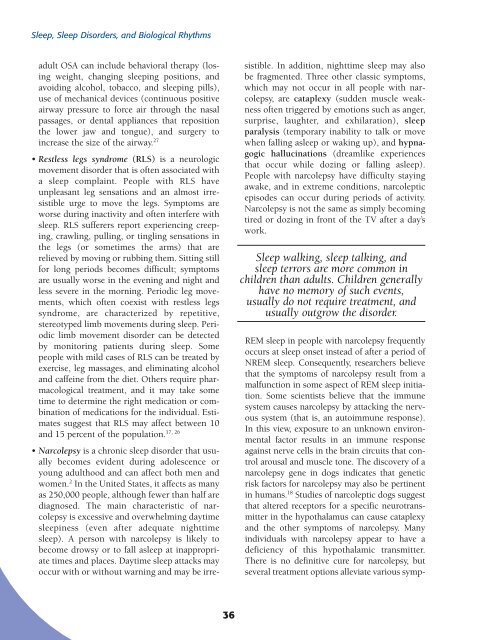Biological - NIH Office of Science Education - National Institutes of ...
Biological - NIH Office of Science Education - National Institutes of ...
Biological - NIH Office of Science Education - National Institutes of ...
You also want an ePaper? Increase the reach of your titles
YUMPU automatically turns print PDFs into web optimized ePapers that Google loves.
Sleep, Sleep Disorders, and <strong>Biological</strong> Rhythms<br />
REM sleep in people with narcolepsy frequently<br />
occurs at sleep onset instead <strong>of</strong> after a period <strong>of</strong><br />
NREM sleep. Consequently, researchers believe<br />
that the symptoms <strong>of</strong> narcolepsy result from a<br />
malfunction in some aspect <strong>of</strong> REM sleep initiation.<br />
Some scientists believe that the immune<br />
system causes narcolepsy by attacking the nervous<br />
system (that is, an autoimmune response).<br />
In this view, exposure to an unknown environmental<br />
factor results in an immune response<br />
against nerve cells in the brain circuits that control<br />
arousal and muscle tone. The discovery <strong>of</strong> a<br />
narcolepsy gene in dogs indicates that genetic<br />
risk factors for narcolepsy may also be pertinent<br />
in humans. 18 Studies <strong>of</strong> narcoleptic dogs suggest<br />
that altered receptors for a specific neurotransmitter<br />
in the hypothalamus can cause cataplexy<br />
and the other symptoms <strong>of</strong> narcolepsy. Many<br />
individuals with narcolepsy appear to have a<br />
deficiency <strong>of</strong> this hypothalamic transmitter.<br />
There is no definitive cure for narcolepsy, but<br />
several treatment options alleviate various sympadult<br />
OSA can include behavioral therapy (losing<br />
weight, changing sleeping positions, and<br />
avoiding alcohol, tobacco, and sleeping pills),<br />
use <strong>of</strong> mechanical devices (continuous positive<br />
airway pressure to force air through the nasal<br />
passages, or dental appliances that reposition<br />
the lower jaw and tongue), and surgery to<br />
increase the size <strong>of</strong> the airway. 27<br />
• Restless legs syndrome (RLS) is a neurologic<br />
movement disorder that is <strong>of</strong>ten associated with<br />
a sleep complaint. People with RLS have<br />
unpleasant leg sensations and an almost irresistible<br />
urge to move the legs. Symptoms are<br />
worse during inactivity and <strong>of</strong>ten interfere with<br />
sleep. RLS sufferers report experiencing creeping,<br />
crawling, pulling, or tingling sensations in<br />
the legs (or sometimes the arms) that are<br />
relieved by moving or rubbing them. Sitting still<br />
for long periods becomes difficult; symptoms<br />
are usually worse in the evening and night and<br />
less severe in the morning. Periodic leg movements,<br />
which <strong>of</strong>ten coexist with restless legs<br />
syndrome, are characterized by repetitive,<br />
stereotyped limb movements during sleep. Periodic<br />
limb movement disorder can be detected<br />
by monitoring patients during sleep. Some<br />
people with mild cases <strong>of</strong> RLS can be treated by<br />
exercise, leg massages, and eliminating alcohol<br />
and caffeine from the diet. Others require pharmacological<br />
treatment, and it may take some<br />
time to determine the right medication or combination<br />
<strong>of</strong> medications for the individual. Estimates<br />
suggest that RLS may affect between 10<br />
17, 26<br />
and 15 percent <strong>of</strong> the population.<br />
• Narcolepsy is a chronic sleep disorder that usually<br />
becomes evident during adolescence or<br />
young adulthood and can affect both men and<br />
women. 2 In the United States, it affects as many<br />
as 250,000 people, although fewer than half are<br />
diagnosed. The main characteristic <strong>of</strong> narcolepsy<br />
is excessive and overwhelming daytime<br />
sleepiness (even after adequate nighttime<br />
sleep). A person with narcolepsy is likely to<br />
become drowsy or to fall asleep at inappropriate<br />
times and places. Daytime sleep attacks may<br />
occur with or without warning and may be irre-<br />
sistible. In addition, nighttime sleep may also<br />
be fragmented. Three other classic symptoms,<br />
which may not occur in all people with narcolepsy,<br />
are cataplexy (sudden muscle weakness<br />
<strong>of</strong>ten triggered by emotions such as anger,<br />
surprise, laughter, and exhilaration), sleep<br />
paralysis (temporary inability to talk or move<br />
when falling asleep or waking up), and hypnagogic<br />
hallucinations (dreamlike experiences<br />
that occur while dozing or falling asleep).<br />
People with narcolepsy have difficulty staying<br />
awake, and in extreme conditions, narcoleptic<br />
episodes can occur during periods <strong>of</strong> activity.<br />
Narcolepsy is not the same as simply becoming<br />
tired or dozing in front <strong>of</strong> the TV after a day’s<br />
work.<br />
Sleep walking, sleep talking, and<br />
sleep terrors are more common in<br />
children than adults. Children generally<br />
have no memory <strong>of</strong> such events,<br />
usually do not require treatment, and<br />
usually outgrow the disorder.<br />
36

















